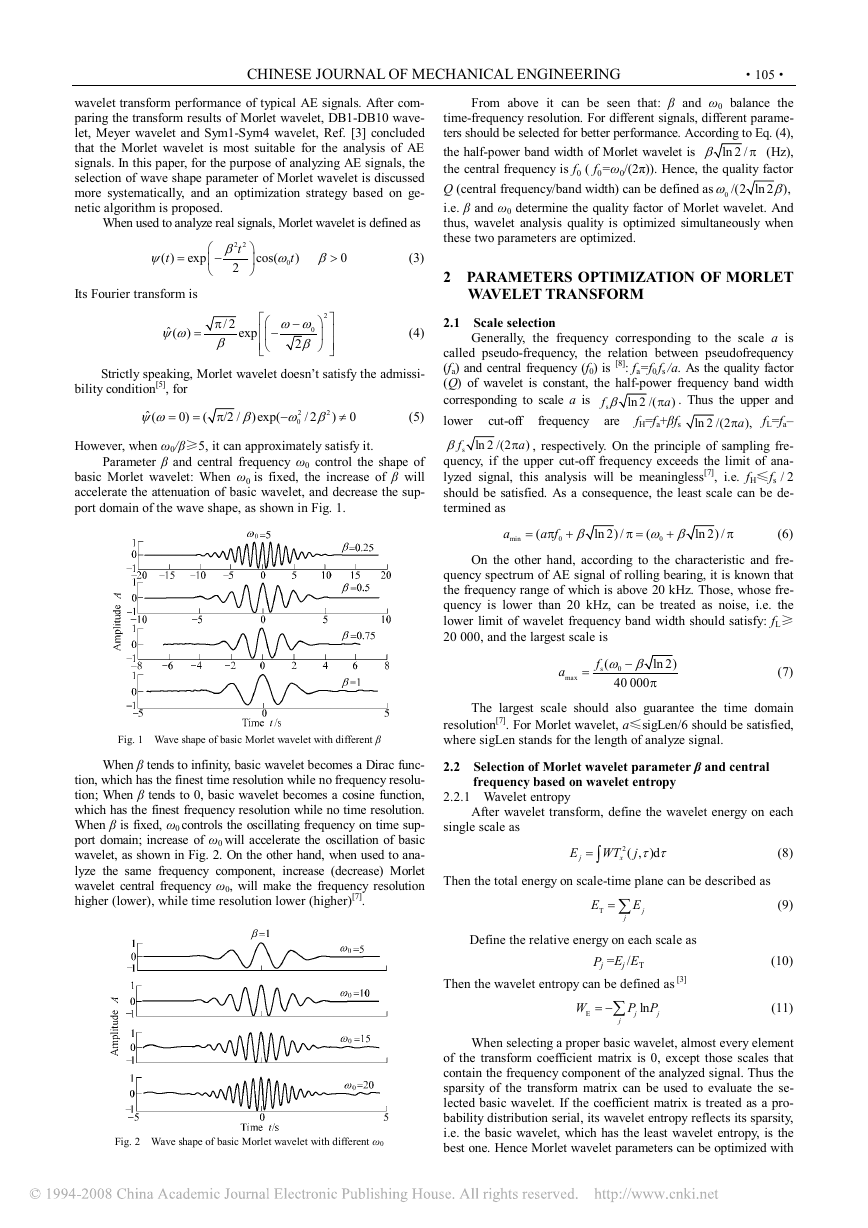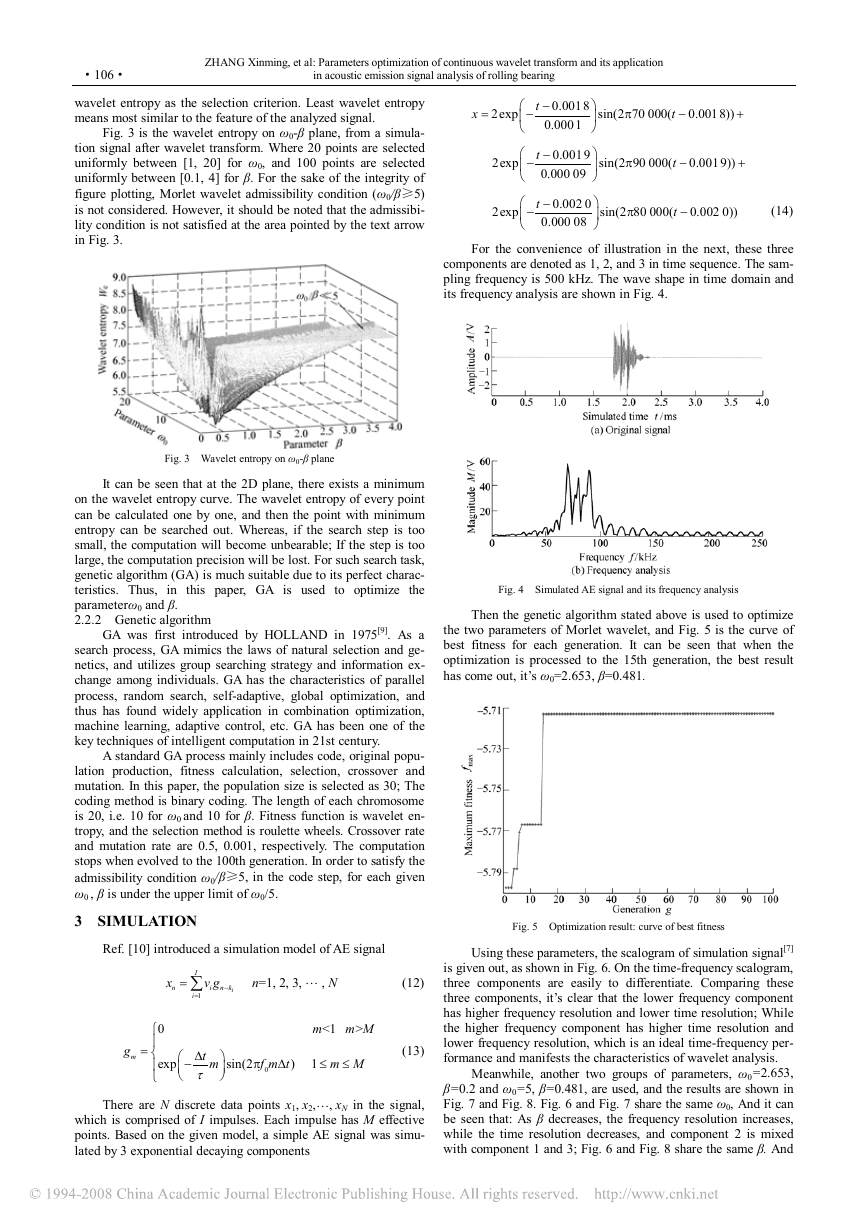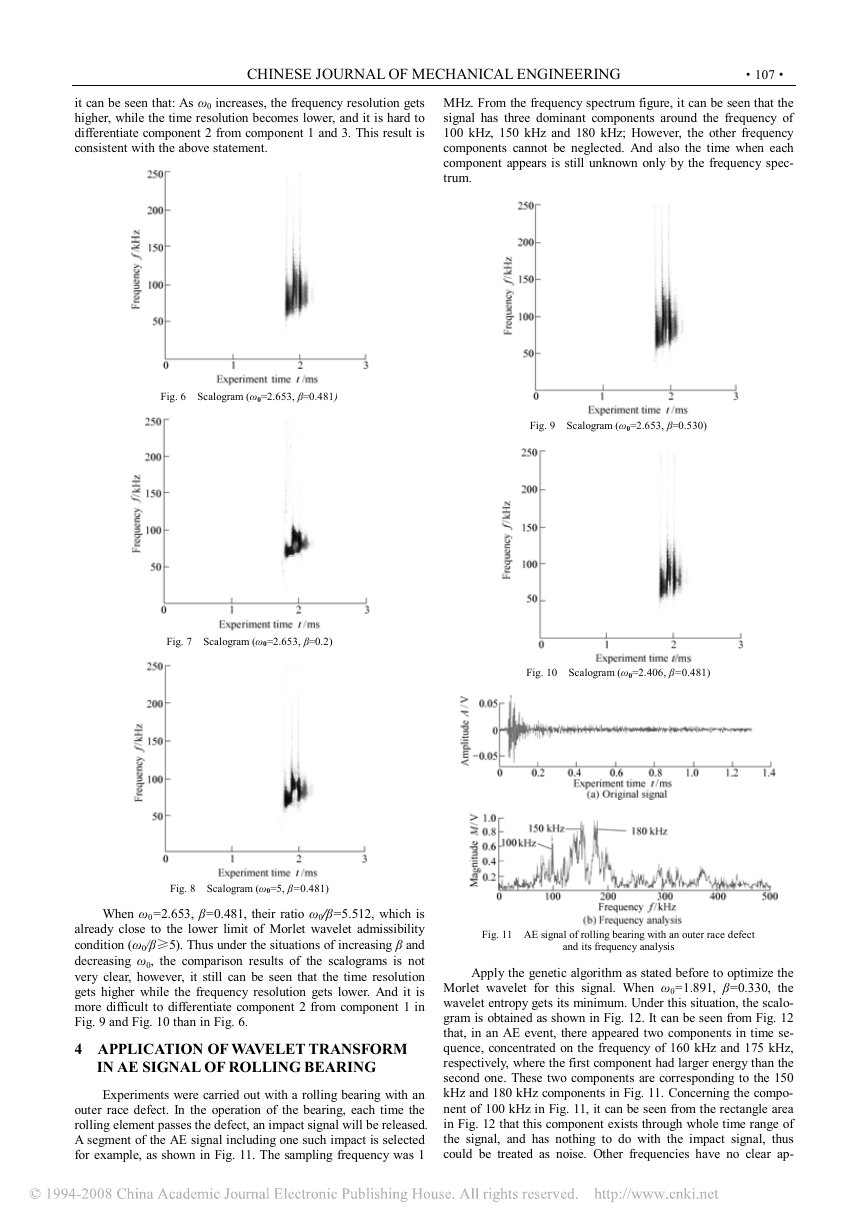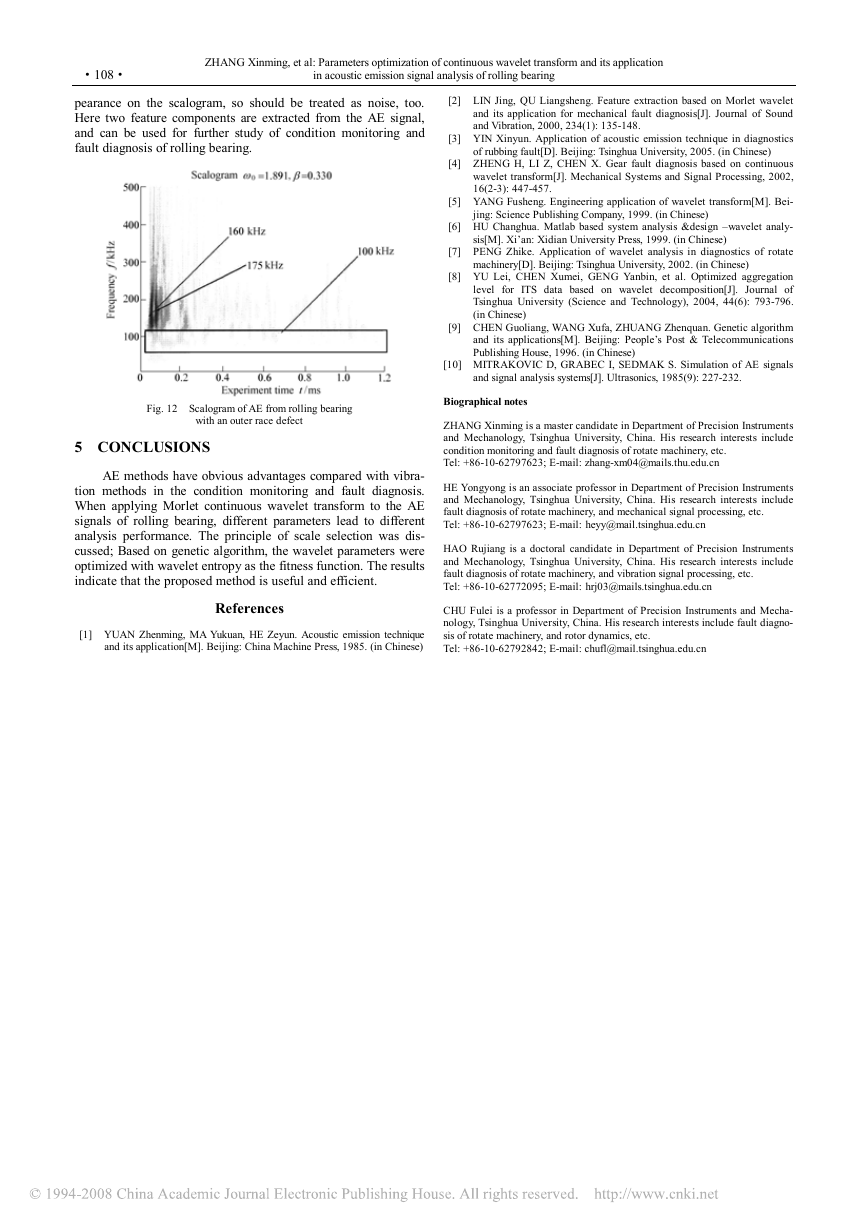CHINESE JOURNAL OF MECHANICAL ENGINEERING
Vol. 20,aNo. 2,a2007
·104·
ZHANG Xinming
HE Yongyong
HAO Rujiang
CHU Fulei
State Key Laboratory of Tribology,
Tsinghua University,
Beijng 100084, China
0 INTRODUCTION
PARAMETERS OPTIMIZATION
OF CONTINUOUS WAVELET
TRANSFORM AND ITS APPLICATION
IN ACOUSTIC EMISSION SIGNAL
ANALYSIS OF ROLLING BEARING*
Abstract: Morlet wavelet is suitable to extract the impulse components of mechanical fault signals.
And thus its continuous wavelet transform (CWT) has been successfully used in the field of fault
diagnosis. The principle of scale selection in CWT is discussed. Based on genetic algorithm, an opti-
mization strategy for the waveform parameters of the mother wavelet is proposed with wavelet en-
tropy as the optimization target. Based on the optimized waveform parameters, the wavelet scalogram
is used to analyze the simulated acoustic emission (AE) signal and real AE signal of rolling bearing.
The results indicate that the proposed method is useful and efficient to improve the quality of CWT.
Key words: Rolling bearing Fault diagnosis Acoustic emission (AE)
Continuous wavelet transform (CWT) Genetic algorithm
Rolling element bearings are of great importance to almost
all forms of rotating machinery. Therefore, bearing failure (e.g.
cracking, spalling) is one of the foremost causes of breakdown in
rotating equipments. As a consequence, the condition monitoring
and fault diagnosis of rolling element bearings are very important.
For rolling element bearings, the most widely used detection
methods are based on vibration signals. Several techniques have
been applied to analyze vibration signals. However, the vibration
signals may be interfered by other sources, and are not sensitive to
the incipient fault, which make it difficult to detect the defect in
early stage.
Acoustic emission technique (AET) is a kind of dynamic
non-destructive technique, developed in 1960s. Particles inside
martial (atoms, molecules and particle swarm) will generate
elastic waves from the transient release of strain energy as a
result of the relative motion. These elastic waves are defined as
acoustic emission (AE), which can be used to understand and
detect the subsurface condition of material[1]. When the rolling
bearing with defects is under operation, the defect (surface de-
fect, cracking or spalling) will generate elastic impact between
the contact surfaces, and give birth to AE. The AE involves
abundant rubbing information and can be used for the condition
monitoring and fault diagnosis of rolling bearing. Different from
the vibration signals, AE signals always have a high frequency
rang (above 20 kHz). So AEs can not be interfered by other me-
chanical vibrations. And that AE are sensitive to early fault. All
of these characteristics make AE methods be of great suitability
and preponderance for the condition monitoring and fault diag-
nosis of rolling bearing.
As vibration signals, AEs of rolling bearing are also
non-stationary and non-linear signals. So it’s efficient to analyze
AEs with wavelet transform. Morlet wavelet has similar wave
shape to the impulse component in the mechanical fault signals [2].
Thus it’s suitable to extract the impact feature of the defect[2-3].
Continuous wavelet transform (CWT) of Morlet has found wide-
spread application in mechanical fault diagnosis[2-4], while the
time-frequency transform performance is affected by parameters
* This project is supported by National Natural Science Foundation of China
(No. 50105007) and Program for New Century Excellent Talents in Uni-
versity, China. Received March 21, 2006; received in revised form Sep-
tember 14, 2006; accepted October 8, 2006
selection. However, how to select the parameters in order to opti-
mize the transform performance is still lack of systematic study,
so far the parameters are generally selected by experience[5-6]. The
parameters selection in Morlet CWT is discussed in detail, and a
principle of scale selection is discussed. Based on genetic algo-
rithm, an optimization strategy for the waveform parameters of
the basic wavelet is proposed. Applying this optimization to the
analysis of rolling bearing AE signals can extract its time-fre-
quency feature, also can develop the AET method for rolling
bearing condition monitoring and fault diagnosis.
1 CONTINUOUS WAVELET TRANSFORM
Let x(t) be a squared integrabel function, i.e. x(t) ∈ L2(R),
the CWT of this function is defined as the integral transform with
a function family ψa,τ(t) as the integral kernel[5], shown as follows
WT a
( , )
τ
x
=
−∞
+∞
∫
1
a
x t
( ),
<
x t
( )
*
ψ
ψ
a
t
( )τ
,
d
t
=
t
τ
−⎛
⎞
⎜
⎟
a
⎝
⎠
>
(1)
where ψa,τ(t) is generated by dilation and translation from the
mother wavelet ψ(t) shown as follows
t
τ
−⎛
⎞
ψ
⎟
⎜
a
⎠
⎝
1
a
(2)
ψ
a
t
( )
=
,
τ
where a is a scale fatcor (in real engineering application, only a>0
is discussed), and τ is time location. The factor a–1/2 is used to
ensure energy preservation. There can be several selections of
mother wavelet ψ(t), but it should satisfy the admissibility condi-
tion and its time-domain should be compact-support.
Compared with discrete wavelet transform (DWT), CWT
has such advantages: The wavelet needn’t to be orthogonal and is
of time invariant; The sampling grids in the time-scale plane are
less sparse. These advantages make CWT more suitable for fea-
ture extraction in mechanical fault signals[2]. However, the
time-frequency transform performance is depended upon the se-
lection of mother wavelet. The principle of this selection is to
make the wave shape of the mother wavelet more similar with the
analyzed signal. And wavelet entropy can reflect such similarity.
Ref. [2] proposed the selection method of mother wavelet based
on wavelet entropy, in order to analyze vibration signal. And the
selection of the shape parameter β of Morlet wavelet is optimized.
Based on the wavelet entropy principle, Ref. [3] discussed the
�
CHINESE JOURNAL OF MECHANICAL ENGINEERING
·105·
wavelet transform performance of typical AE signals. After com-
paring the transform results of Morlet wavelet, DB1-DB10 wave-
let, Meyer wavelet and Sym1-Sym4 wavelet, Ref. [3] concluded
that the Morlet wavelet is most suitable for the analysis of AE
signals. In this paper, for the purpose of analyzing AE signals, the
selection of wave shape parameter of Morlet wavelet is discussed
more systematically, and an optimization strategy based on ge-
netic algorithm is proposed.
When used to analyze real signals, Morlet wavelet is defined as
From above it can be seen that: β and ω0 balance the
time-frequency resolution. For different signals, different parame-
ters should be selected for better performance. According to Eq. (4),
π (Hz),
the half-power band width of Morlet wavelet is
the central frequency is f0 ( f0=ω0/(2π)). Hence, the quality factor
Q (central frequency/band width) can be defined as
/(2 ln 2 ),
β
i.e. β and ω0 determine the quality factor of Morlet wavelet. And
thus, wavelet analysis quality is optimized simultaneously when
these two parameters are optimized.
ln 2 /
ω
0
β
ψ
t
( )
⎛
⎜
⎝
Its Fourier transform is
exp
=
−
t
2 2
β
2
⎞
⎟
⎠
cos(
ω β
)
t
0
>
0
(3)
2 PARAMETERS OPTIMIZATION OF MORLET
WAVELET TRANSFORM
ˆ(
)
ψω
=
/ 2
π
β
exp
⎡
⎢
⎢
⎣
⎛
−⎜
⎝
−
ω ω
0
2
β
2
⎞
⎟
⎠
⎤
⎥
⎥
⎦
(4)
Strictly speaking, Morlet wavelet doesn’t satisfy the admissi-
bility condition[5], for
ˆ(
ψω
=
0)
=
(
π/2
/
β
)exp(
ω β2
−
/ 2
2
0
)
≠
0
(5)
However, when ω0/β≥5, it can approximately satisfy it.
Parameter β and central frequency ω0 control the shape of
basic Morlet wavelet: When ω0 is fixed, the increase of β will
accelerate the attenuation of basic wavelet, and decrease the sup-
port domain of the wave shape, as shown in Fig. 1.
Fig. 1 Wave shape of basic Morlet wavelet with different β
When β tends to infinity, basic wavelet becomes a Dirac func-
tion, which has the finest time resolution while no frequency resolu-
tion; When β tends to 0, basic wavelet becomes a cosine function,
which has the finest frequency resolution while no time resolution.
When β is fixed, ω0 controls the oscillating frequency on time sup-
port domain; increase of ω0 will accelerate the oscillation of basic
wavelet, as shown in Fig. 2. On the other hand, when used to ana-
lyze the same frequency component, increase (decrease) Morlet
wavelet central frequency ω0, will make the frequency resolution
higher (lower), while time resolution lower (higher)[7].
2.1 Scale selection
Generally, the frequency corresponding to the scale a is
called pseudo-frequency, the relation between pseudofrequency
(fa) and central frequency (f0) is [8]: fa=f0 fs /a. As the quality factor
(Q) of wavelet is constant, the half-power frequency band width
corresponding to scale a is
a . Thus the upper and
)
ln 2 /(
π
fH=fa+βfs
fL=fa–
cut-off
frequency
lower
a , respectively. On the principle of sampling fre-
f
)
π
β
quency, if the upper cut-off frequency exceeds the limit of ana-
lyzed signal, this analysis will be meaningless[7], i.e. fH≤fs / 2
should be satisfied. As a consequence, the least scale can be de-
termined as
a
a f β
= π +
f
β
s
are
(
ω β
ln 2 /(2
ln 2 /(2
ln 2) /
ln 2) /
),aπ
(6)
π =
π
+
(
s
0
min
0
On the other hand, according to the characteristic and fre-
quency spectrum of AE signal of rolling bearing, it is known that
the frequency range of which is above 20 kHz. Those, whose fre-
quency is lower than 20 kHz, can be treated as noise, i.e. the
lower limit of wavelet frequency band width should satisfy: fL≥
20 000, and the largest scale is
a
max
=
f
s
(
ω β0 −
40 000
ln 2)
π
(7)
The largest scale should also guarantee the time domain
resolution[7]. For Morlet wavelet, a≤sigLen/6 should be satisfied,
where sigLen stands for the length of analyze signal.
2.2 Selection of Morlet wavelet parameter β and central
frequency based on wavelet entropy
2.2.1 Wavelet entropy
After wavelet transform, define the wavelet energy on each
single scale as
E
j
= ∫
WT j τ τ
2( , )d
x
Then the total energy on scale-time plane can be described as
E
E
T
= ∑
j
j
(8)
(9)
Define the relative energy on each scale as
Then the wavelet entropy can be defined as [3]
Pj =Ej /ET
P P
lnj
j
= −∑
W
E
j
(10)
(11)
Fig. 2 Wave shape of basic Morlet wavelet with different ω0
When selecting a proper basic wavelet, almost every element
of the transform coefficient matrix is 0, except those scales that
contain the frequency component of the analyzed signal. Thus the
sparsity of the transform matrix can be used to evaluate the se-
lected basic wavelet. If the coefficient matrix is treated as a pro-
bability distribution serial, its wavelet entropy reflects its sparsity,
i.e. the basic wavelet, which has the least wavelet entropy, is the
best one. Hence Morlet wavelet parameters can be optimized with
�
·106·
ZHANG Xinming, et al: Parameters optimization of continuous wavelet transform and its application
YZHANG Xinming, et al: Parameters optimization of continuous wavelet transform and its application in acoustic Y
in acoustic emission signal analysis of rolling bearing
wavelet entropy as the selection criterion. Least wavelet entropy
means most similar to the feature of the analyzed signal.
Fig. 3 is the wavelet entropy on ω0-β plane, from a simula-
tion signal after wavelet transform. Where 20 points are selected
uniformly between [1, 20] for ω0, and 100 points are selected
uniformly between [0.1, 4] for β. For the sake of the integrity of
figure plotting, Morlet wavelet admissibility condition (ω0/β≥5)
is not considered. However, it should be noted that the admissibi-
lity condition is not satisfied at the area pointed by the text arrow
in Fig. 3.
x
=
2exp
2exp
2exp
⎛
⎜
⎝
⎛
⎜
⎝
⎛
⎜
⎝
t
−
0.0018
−
0.0001
−
t
0.0019
−
0.000 09
⎞
⎟
⎠
⎞
⎟
⎠
t
sin(2 70 000(
π
−
0.0018))
+
sin(2 90 000(
π
t
−
0.0019))
+
−
t
0.002 0
−
0.000 08
⎞
⎟
⎠
t
sin(2 80 000(
π
−
0.002 0))
(14)
For the convenience of illustration in the next, these three
components are denoted as 1, 2, and 3 in time sequence. The sam-
pling frequency is 500 kHz. The wave shape in time domain and
its frequency analysis are shown in Fig. 4.
Fig. 4 Simulated AE signal and its frequency analysis
Then the genetic algorithm stated above is used to optimize
the two parameters of Morlet wavelet, and Fig. 5 is the curve of
best fitness for each generation. It can be seen that when the
optimization is processed to the 15th generation, the best result
has come out, it’s ω0=2.653, β=0.481.
Fig. 5 Optimization result: curve of best fitness
Using these parameters, the scalogram of simulation signal[7]
is given out, as shown in Fig. 6. On the time-frequency scalogram,
three components are easily to differentiate. Comparing these
three components, it’s clear that the lower frequency component
has higher frequency resolution and lower time resolution; While
the higher frequency component has higher time resolution and
lower frequency resolution, which is an ideal time-frequency per-
formance and manifests the characteristics of wavelet analysis.
Meanwhile, another two groups of parameters, ω0=2.653,
β=0.2 and ω0=5, β=0.481, are used, and the results are shown in
Fig. 7 and Fig. 8. Fig. 6 and Fig. 7 share the same ω0, And it can
be seen that: As β decreases, the frequency resolution increases,
while the time resolution decreases, and component 2 is mixed
with component 1 and 3; Fig. 6 and Fig. 8 share the same β. And
Fig. 3 Wavelet entropy on ω0-β plane
It can be seen that at the 2D plane, there exists a minimum
on the wavelet entropy curve. The wavelet entropy of every point
can be calculated one by one, and then the point with minimum
entropy can be searched out. Whereas, if the search step is too
small, the computation will become unbearable; If the step is too
large, the computation precision will be lost. For such search task,
genetic algorithm (GA) is much suitable due to its perfect charac-
teristics. Thus, in this paper, GA is used to optimize the
parameterω0 and β.
2.2.2 Genetic algorithm
GA was first introduced by HOLLAND in 1975[9]. As a
search process, GA mimics the laws of natural selection and ge-
netics, and utilizes group searching strategy and information ex-
change among individuals. GA has the characteristics of parallel
process, random search, self-adaptive, global optimization, and
thus has found widely application in combination optimization,
machine learning, adaptive control, etc. GA has been one of the
key techniques of intelligent computation in 21st century.
A standard GA process mainly includes code, original popu-
lation production, fitness calculation, selection, crossover and
mutation. In this paper, the population size is selected as 30; The
coding method is binary coding. The length of each chromosome
is 20, i.e. 10 for ω0 and 10 for β. Fitness function is wavelet en-
tropy, and the selection method is roulette wheels. Crossover rate
and mutation rate are 0.5, 0.001, respectively. The computation
stops when evolved to the 100th generation. In order to satisfy the
admissibility condition ω0/β≥5, in the code step, for each given
ω0 , β is under the upper limit of ω0/5.
3 SIMULATION
Ref. [10] introduced a simulation model of AE signal
g
m
⎧
⎪
= ⎨
⎪
⎩
x
n
I
= ∑
i
1
=
v g −
i
n k
i
n=1, 2, 3, … , N
(12)
0 <1 >
m M
m
exp
t m
∆⎛
−
⎜
τ
⎝
⎞
⎟
⎠
sin(2
f m t
π
∆
0
) 1
≤
m M
≤
(13)
There are N discrete data points x1, x2,…, xN in the signal,
which is comprised of I impulses. Each impulse has M effective
points. Based on the given model, a simple AE signal was simu-
lated by 3 exponential decaying components
�
CHINESE JOURNAL OF MECHANICAL ENGINEERING
·107·
it can be seen that: As ω0 increases, the frequency resolution gets
higher, while the time resolution becomes lower, and it is hard to
differentiate component 2 from component 1 and 3. This result is
consistent with the above statement.
MHz. From the frequency spectrum figure, it can be seen that the
signal has three dominant components around the frequency of
100 kHz, 150 kHz and 180 kHz; However, the other frequency
components cannot be neglected. And also the time when each
component appears is still unknown only by the frequency spec-
trum.
Fig. 9 Scalogram (ω0=2.653, β=0.530)
Fig. 10 Scalogram (ω0=2.406, β=0.481)
Fig. 6 Scalogram (ω0=2.653, β=0.481)
Fig. 7 Scalogram (ω0=2.653, β=0.2)
Fig. 8 Scalogram (ω0=5, β=0.481)
When ω0=2.653, β=0.481, their ratio ω0/β=5.512, which is
already close to the lower limit of Morlet wavelet admissibility
condition (ω0/β≥5). Thus under the situations of increasing β and
decreasing ω0, the comparison results of the scalograms is not
very clear, however, it still can be seen that the time resolution
gets higher while the frequency resolution gets lower. And it is
more difficult to differentiate component 2 from component 1 in
Fig. 9 and Fig. 10 than in Fig. 6.
4 APPLICATION OF WAVELET TRANSFORM
IN AE SIGNAL OF ROLLING BEARING
Experiments were carried out with a rolling bearing with an
outer race defect. In the operation of the bearing, each time the
rolling element passes the defect, an impact signal will be released.
A segment of the AE signal including one such impact is selected
for example, as shown in Fig. 11. The sampling frequency was 1
Fig. 11 AE signal of rolling bearing with an outer race defect
and its frequency analysis
Apply the genetic algorithm as stated before to optimize the
Morlet wavelet for this signal. When ω0=1.891, β=0.330, the
wavelet entropy gets its minimum. Under this situation, the scalo-
gram is obtained as shown in Fig. 12. It can be seen from Fig. 12
that, in an AE event, there appeared two components in time se-
quence, concentrated on the frequency of 160 kHz and 175 kHz,
respectively, where the first component had larger energy than the
second one. These two components are corresponding to the 150
kHz and 180 kHz components in Fig. 11. Concerning the compo-
nent of 100 kHz in Fig. 11, it can be seen from the rectangle area
in Fig. 12 that this component exists through whole time range of
the signal, and has nothing to do with the impact signal, thus
could be treated as noise. Other frequencies have no clear ap-
�
·108·
ZHANG Xinming, et al: Parameters optimization of continuous wavelet transform and its application
YZHANG Xinming, et al: Parameters optimization of continuous wavelet transform and its application in acoustic Y
in acoustic emission signal analysis of rolling bearing
pearance on the scalogram, so should be treated as noise, too.
Here two feature components are extracted from the AE signal,
and can be used for further study of condition monitoring and
fault diagnosis of rolling bearing.
Biographical notes
Fig. 12 Scalogram of AE from rolling bearing
with an outer race defect
5 CONCLUSIONS
AE methods have obvious advantages compared with vibra-
tion methods in the condition monitoring and fault diagnosis.
When applying Morlet continuous wavelet transform to the AE
signals of rolling bearing, different parameters lead to different
analysis performance. The principle of scale selection was dis-
cussed; Based on genetic algorithm, the wavelet parameters were
optimized with wavelet entropy as the fitness function. The results
indicate that the proposed method is useful and efficient.
References
[1] YUAN Zhenming, MA Yukuan, HE Zeyun. Acoustic emission technique
and its application[M]. Beijing: China Machine Press, 1985. (in Chinese)
[2] LIN Jing, QU Liangsheng. Feature extraction based on Morlet wavelet
and its application for mechanical fault diagnosis[J]. Journal of Sound
and Vibration, 2000, 234(1): 135-148.
of rubbing fault[D]. Beijing: Tsinghua University, 2005. (in Chinese)
[3] YIN Xinyun. Application of acoustic emission technique in diagnostics
[4] ZHENG H, LI Z, CHEN X. Gear fault diagnosis based on continuous
wavelet transform[J]. Mechanical Systems and Signal Processing, 2002,
16(2-3): 447-457.
[5] YANG Fusheng. Engineering application of wavelet transform[M]. Bei-
jing: Science Publishing Company, 1999. (in Chinese)
[6] HU Changhua. Matlab based system analysis &design –wavelet analy-
sis[M]. Xi’an: Xidian University Press, 1999. (in Chinese)
[7] PENG Zhike. Application of wavelet analysis in diagnostics of rotate
machinery[D]. Beijing: Tsinghua University, 2002. (in Chinese)
[8] YU Lei, CHEN Xumei, GENG Yanbin, et al. Optimized aggregation
level for ITS data based on wavelet decomposition[J]. Journal of
Tsinghua University (Science and Technology), 2004, 44(6): 793-796.
(in Chinese)
[9] CHEN Guoliang, WANG Xufa, ZHUANG Zhenquan. Genetic algorithm
and its applications[M]. Beijing: People’s Post & Telecommunications
Publishing House, 1996. (in Chinese)
[10] MITRAKOVIC D, GRABEC I, SEDMAK S. Simulation of AE signals
and signal analysis systems[J]. Ultrasonics, 1985(9): 227-232.
ZHANG Xinming is a master candidate in Department of Precision Instruments
and Mechanology, Tsinghua University, China. His research interests include
condition monitoring and fault diagnosis of rotate machinery, etc.
Tel: +86-10-62797623; E-mail: zhang-xm04@mails.thu.edu.cn
HE Yongyong is an associate professor in Department of Precision Instruments
and Mechanology, Tsinghua University, China. His research interests include
fault diagnosis of rotate machinery, and mechanical signal processing, etc.
Tel: +86-10-62797623; E-mail: heyy@mail.tsinghua.edu.cn
HAO Rujiang is a doctoral candidate in Department of Precision Instruments
and Mechanology, Tsinghua University, China. His research interests include
fault diagnosis of rotate machinery, and vibration signal processing, etc.
Tel: +86-10-62772095; E-mail: hrj03@mails.tsinghua.edu.cn
CHU Fulei is a professor in Department of Precision Instruments and Mecha-
nology, Tsinghua University, China. His research interests include fault diagno-
sis of rotate machinery, and rotor dynamics, etc.
Tel: +86-10-62792842; E-mail: chufl@mail.tsinghua.edu.cn
�










 2023年江西萍乡中考道德与法治真题及答案.doc
2023年江西萍乡中考道德与法治真题及答案.doc 2012年重庆南川中考生物真题及答案.doc
2012年重庆南川中考生物真题及答案.doc 2013年江西师范大学地理学综合及文艺理论基础考研真题.doc
2013年江西师范大学地理学综合及文艺理论基础考研真题.doc 2020年四川甘孜小升初语文真题及答案I卷.doc
2020年四川甘孜小升初语文真题及答案I卷.doc 2020年注册岩土工程师专业基础考试真题及答案.doc
2020年注册岩土工程师专业基础考试真题及答案.doc 2023-2024学年福建省厦门市九年级上学期数学月考试题及答案.doc
2023-2024学年福建省厦门市九年级上学期数学月考试题及答案.doc 2021-2022学年辽宁省沈阳市大东区九年级上学期语文期末试题及答案.doc
2021-2022学年辽宁省沈阳市大东区九年级上学期语文期末试题及答案.doc 2022-2023学年北京东城区初三第一学期物理期末试卷及答案.doc
2022-2023学年北京东城区初三第一学期物理期末试卷及答案.doc 2018上半年江西教师资格初中地理学科知识与教学能力真题及答案.doc
2018上半年江西教师资格初中地理学科知识与教学能力真题及答案.doc 2012年河北国家公务员申论考试真题及答案-省级.doc
2012年河北国家公务员申论考试真题及答案-省级.doc 2020-2021学年江苏省扬州市江都区邵樊片九年级上学期数学第一次质量检测试题及答案.doc
2020-2021学年江苏省扬州市江都区邵樊片九年级上学期数学第一次质量检测试题及答案.doc 2022下半年黑龙江教师资格证中学综合素质真题及答案.doc
2022下半年黑龙江教师资格证中学综合素质真题及答案.doc